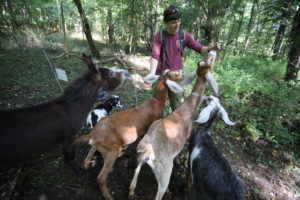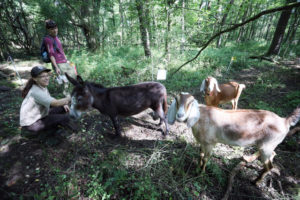Goats Come to the Rescue, Thanks to Allegheny Class Research Project
If you venture into the Erie National Wildlife Refuge east of Meadville as the summer winds down, you’ll likely come across eight well-fed goats who are gorging themselves on non-native plants and savoring every bite.

They probably won’t even notice you staring at them as they chew.
The goats were brought in for the summer of 2019 to help the wildlife refuge manage an infestation of an invasive shrub species known as multiflora rose, which was brought from Asia to western Pennsylvania and other areas of the northeastern and midwestern United States more than a century ago. The flowering shrubs are eye-catching and were initially used as wildlife habitat. However, they crowd out native plants and are spreading uncontrolled into private and public lands. In many states, they are classified as a noxious weed.
The eight goats, who clear the plants from about a third of an acre each week, include three Nigerian dwarves, three Nubians, and one Alpine, says Brian Capron, a 2019 Allegheny College graduate who tends the herd. There is also a “guard donkey” named Diamond who watches over the goats and scares off coyotes who may be on the prowl. “Each of the animals has a unique personality, which makes them very interesting and fun to work with,” says Capron.
Two years ago, the Environmental Research Methods class, taught by Allegheny Professor of Environmental Science and Sustainability Rich Bowden, was asked by officials at the Erie National Wildlife Refuge in Crawford County to survey the alarming takeover of the flora by the multiflora rose and to recommend sustainable, non-chemical ways they might eradicate the rapidly spreading plant.
“The multiflora rose was brought here because it provides dense cover for wildlife, and in the fall, it yields nutritious rose hips eaten by birds and small mammals. The problem is that there are no native controls on the growth of the plant, which grows rapidly and crowds out other valuable native plants,” says Bowden. “The refuge needed to quantify the extent of the problem, and this seemed like a perfect project for a sophomore-oriented research course.
“After a lot of work trudging through vast areas of thorny rose bushes, we got the data showing how extensive the problem was, and then looked at possible solutions. The refuge wanted to avoid using chemicals, and it’s too hard to dig up these plants across large areas,” added Bowden. “But, one student found a study showing that goats could be a viable sustainable option,” he said.
Based on the survey data, Wildlife Biologist Melissa Althouse this summer “hired” the goats from Allegheny Goatscape, a 501(c)3 nonprofit organization founded and directed by Gavin Deming, whose mission is “to reduce invasive and unwanted vegetation in public spaces and vacant lots, utilizing goats for browsing” in and around the Pittsburgh area. These goats munch down as much invasive foliage as they can stomach — and that’s quite a bit.

“Yeah, they have voracious appetites,” says Capron, who was an environmental science major and German minor at Allegheny. The goats are moved every week according to a grid system that Capron and Althouse have established, moving the goats around the wildlife refuge.
Capron, who was a member of Bowden’s environmental science class, must tend to the herd each morning. “When we first started this project my responsibilities were essentially to ensure that the herd was still in the fence, but after a brief learning curve, and one or two escape attempts, we have established a solid morning routine for our goats. After the requisite headcount, I refill their water trough, hand out grain and a few treats, and inspect the electric fence for shorts or snags. We also apply an anti-fly ointment to our donkey’s legs and face to keep her in good spirits. Other than this daily maintenance, I assist Melissa in flagging, cutting a perimeter, and setting up the fence for our next unit.”
The goats have saved the natural environment from being doused with chemicals to control the invasive plants. “To clear an area this size of multiflora rose would usually require a small team of people and a lot of herbicides potentially leaching into the environment, but with our goat herd we’ve been able to massively reduce the multiflora rose biomass without spraying any chemicals. So far the project has been an enormous success in invasive species management,” says Capron, who is working as a paid intern this summer.
Bowden’s environmental science class will return to the wildlife refuge in the fall of 2019 for a follow-up survey. “They asked us to come back and assess how successful the project has been,” he says. “The work teaches students how to do environmental research in a hands-on manner, and the refuge, with its very small staff, gains management information that they would not have time to obtain on their own.
“The students like to do real work for real clients. The refuge is run by a federal agency, so it really gives the students the sense of adding real meaning to their work.”
The wildlife refuge is hosting an open house to share the goat project with the public at 6:30 p.m. Friday, August 23, starting at the Visitors Center.
A final note: wildlife biologist Althouse will be teaching a course at Allegheny this fall, tentatively called “Applied Conservation Problems.”